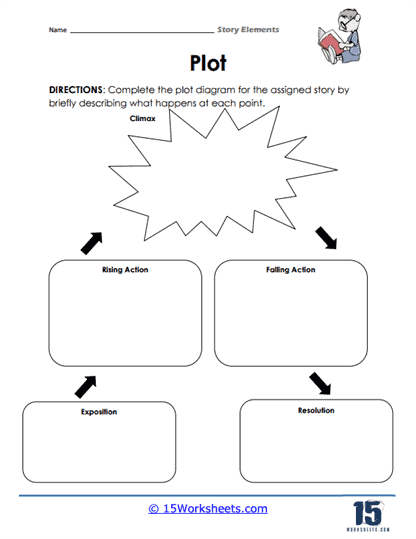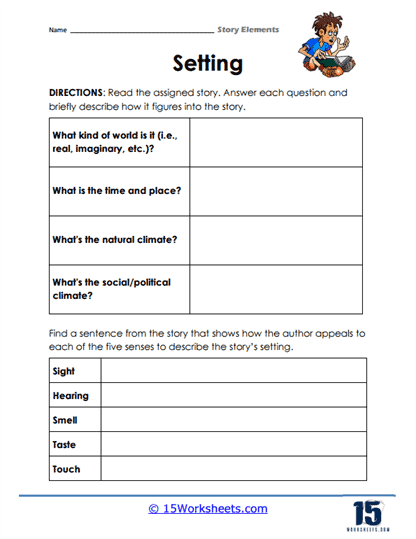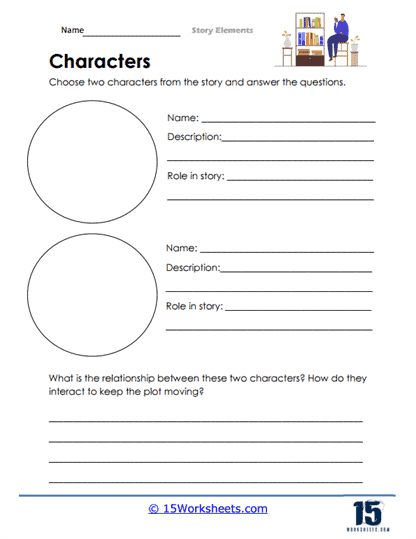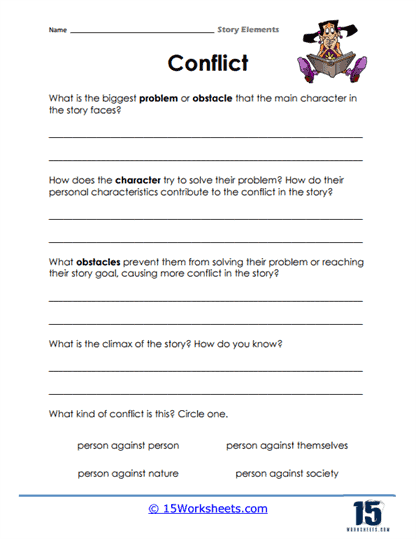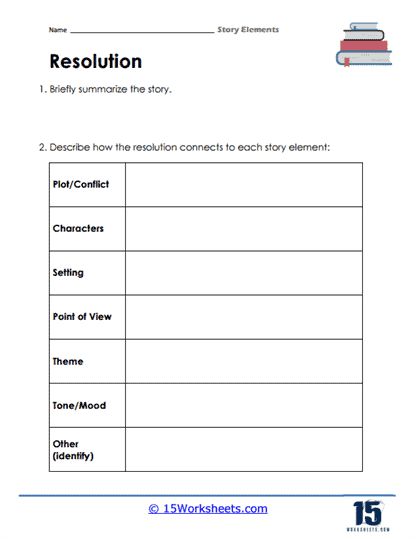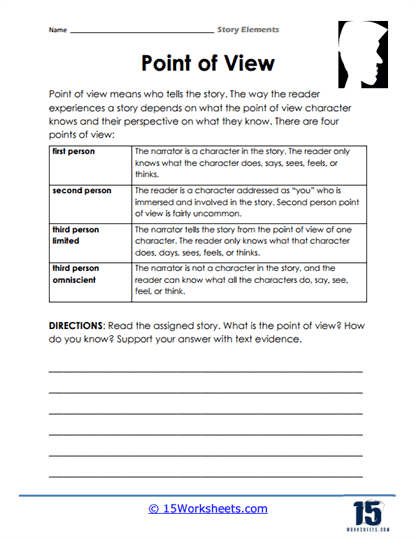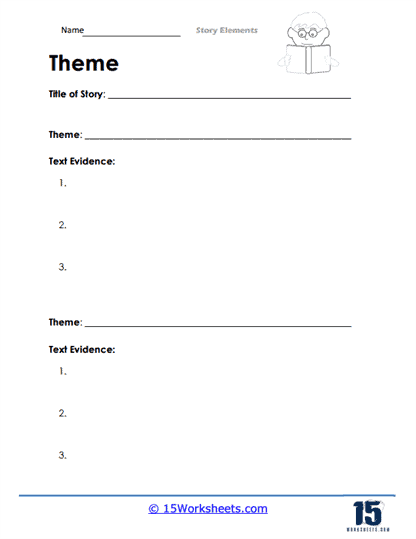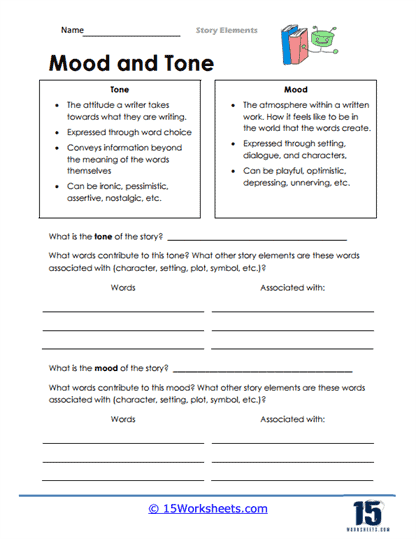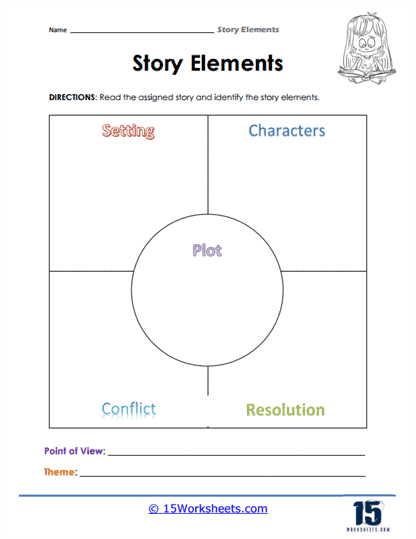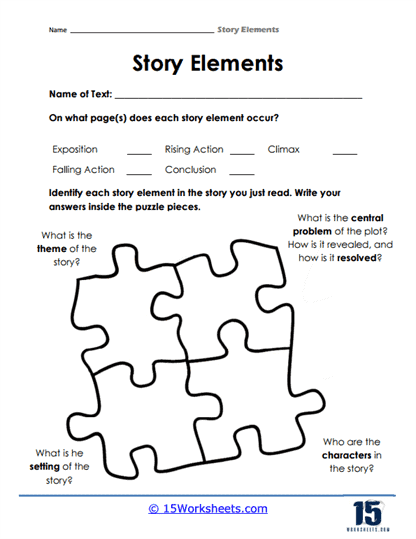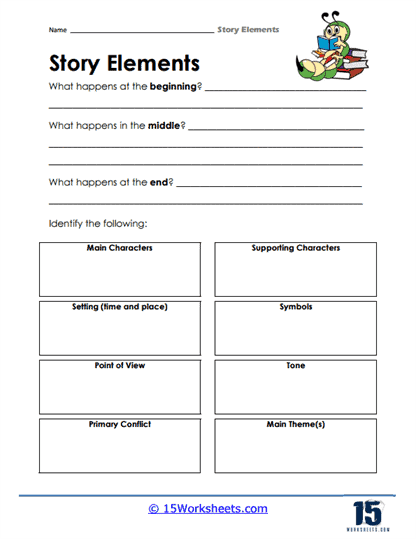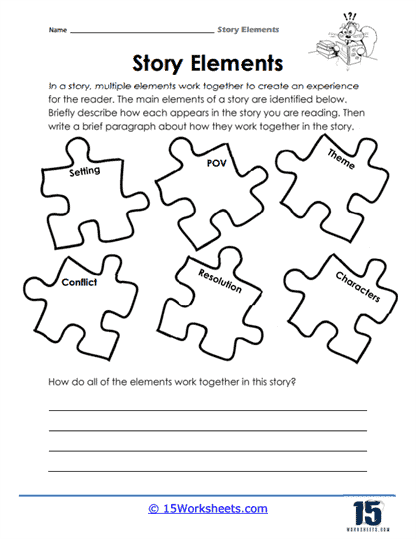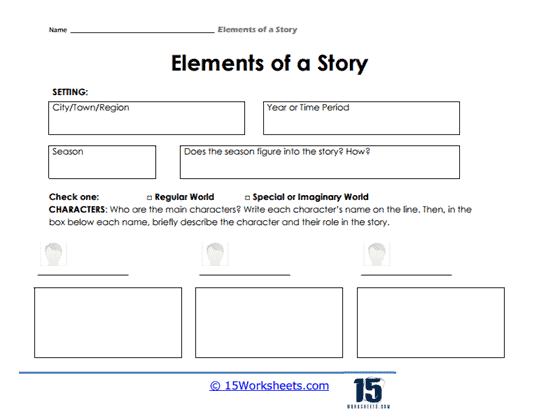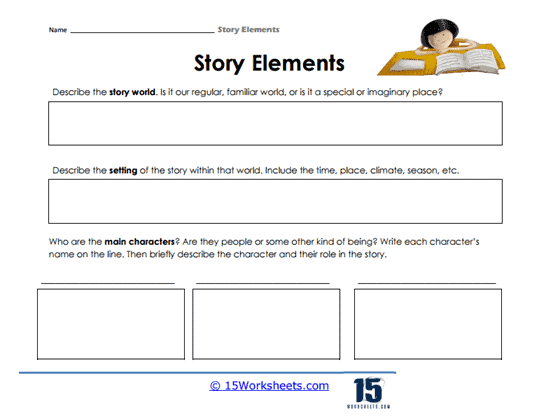Elements of a Story Worksheets
All About These 15 Worksheets
Stories are windows into different worlds, and understanding the fundamental elements of a story is key to unlocking their magic. This Elements of a Story Worksheets Collection is a comprehensive resource designed to empower students with the knowledge and skills needed to deconstruct and appreciate the art of storytelling.
This collection comprises 15 worksheets, each meticulously crafted to guide students through the essential components that make up a narrative. In this description, we will explore the importance of studying the elements of a story and the numerous benefits it offers to students.
A Look At These Worksheets
Step into the wild, wondrous world of storytelling, where students become literary explorers armed with pencils and curiosity. This collection of “Elements of a Story” worksheets doesn’t just explain narrative-it throws students straight into the heart of it, asking them to poke, prod, rearrange, and breathe life into every piece of a story’s anatomy. We begin, naturally, with who’s telling the tale. With “Identifying the POV” and “Perspective Detective,” students are launched into the sneaky business of perspective. Is this narrator trustworthy? Are they hiding something? Why does everyone in this story sound like your weird cousin Jeff? These worksheets turn voice analysis into a whodunit, sharpening students’ awareness of how stories shift when the storyteller changes.
Next, we tackle plot-but not with yawn-worthy diagrams. “Plotting the Tale,” “Beginning, Middle, End,” “Linking the Resolution,” and “Unraveling the Narrative” ask students to dissect and rebuild story structure like narrative engineers. Think of it as story surgery: identifying the heartbeat, fixing broken climaxes, and making sure resolutions don’t just wander off mumbling. These activities blend the science of narrative flow with the art of timing. “Elements in the Puzzle” raises the stakes-students must reassemble scrambled narrative parts, proving they know not just what makes a story, but how it breathes.
A great story doesn’t live on plot alone-it needs a setting that sings and characters that argue about directions. Enter “Setting the Scene,” where students become architects of atmosphere. They’re challenged to describe not just where, but how a setting feels-foggy? futuristic? emotionally claustrophobic? “Analyzing Key Relationships” and “Conflict Categories” zoom in further, helping students map character dynamics and emotional tensions. Suddenly, stories become more than action-they’re human dramas, full of grudges, loyalties, and awkward family dinners.
Just when students think they’ve grasped the meat of the story, the worksheets throw in soul-searching layers. “Tone and Mood Unveiled” and “Double Theme Dive” introduce the emotional and philosophical seasoning. Is this tale grim or goofy? Is the theme about love, loss, power, or the horror of sharing a room with your brother? These worksheets give students the language to talk about the vibe of a story-and why that vibe makes readers feel something. They’re hilarious in the way they reveal misreadings (“I thought the tone was ‘spooky’ because there was a crow”) but deeply revealing, too.
From there, it’s time for world domination-er, world-building. “World-Building and Character Portraits” and “Creating Literary Magic” invite students to become gods of their own narrative universes. What laws govern this place? What haunts your hero’s dreams? These exercises fuse art and empathy, prompting students to create entire lives out of thin air, then make those lives matter. They get a little weird-in the best way. Some characters end up with pet dragons or irrational fears of cheese, and it’s beautiful. Because students learn that good stories don’t just entertain-they reflect, surprise, and sometimes make you snort with laughter.
We bring it all together with the “Story Placemat“-a colorful, visual storytelling smorgasbord that lets students showcase everything they’ve learned, from mood to theme to plot twists. It’s a satisfying finale, like a pie chart made of narrative pie. These worksheets aren’t just about checking boxes; they train students to think like authors, critics, psychologists, and dreamers all at once. In the end, the true magic isn’t just understanding the elements of a story-it’s realizing that you can build one yourself, and it can be anything: brave, silly, tragic, hopeful, or all of the above.
What Are the Elements of a Story?
Stories are beautiful narratives of fantasy elements, vivid descriptions, wicked characters, heroic savers of the day, complex plots, unpredictable twists, and what not.
But no matter which kind of stories you prefer to read or write, they all are based upon the same structure and essential elements. Every good story captivates its reader with a unique tale that has never been heard before, but every one of them stands on the same seven elements of a story, which ensures it is well-written and exciting.
The elements of a story work together to create an intricate structure. The order of these elements doesn’t matter, as long as they all are perfectly executed and blended into your story.
What Are the 6 Elements of a Story?
1. Plot
Simply put, the plot is the series of events in a story. A plot is a foundation upon which all other story elements depend. If your plot is weak and doesn’t support the theme and idea of your story, then it wouldn’t work.
A plot consists of a beginning, middle, and end, yet a skillful writer would manage to add elements of surprise and twists to the same arc of a plot.
A plot describes every event that happens in a book or story. However, in short stories, writers often focus more on the tone and characters rather than building a complex plot.
2. Characters
There are two main characters in every story. The protagonist, your primary character, and antagonist work against the protagonist.
Most stories involve more than one character, but it needs to be understood that the character development of the primary protagonist and antagonist must be well-executed and flawless.
The thoughts and ideas, tone of dialogues, and internal conflicts of the characters must be shown and not told.
A relatable character feels real and connects with the reader, making a lasting impression of the story. Giving depth and humanity to your character makes a reader root for them as the story progresses.
3. Theme
The theme of a story is a general idea or the message that the story portrays through its characters and plot. Some common themes are good versus evil, redemption, the pursuit of love, coming of age, etc.
A theme can give clues about the upcoming events in a story through repeated words or descriptions.
Or a theme can provide a deeper meaning to a story. When you are passionately describing your favorite story or book, most of the time, you focus on the theme that made you love it rather than the actual plot of the book.
4. Tension or Conflict
Tension or conflict in a story drives the action. A conflict always demands confrontation or argument, making you concerned about the characters.
Tension or conflict is something that keeps your protagonist from achieving their goal. It also drives them to work against it continuously. Your protagonist and antagonist always have different interests, which is how tension develops in the story.
A conflict cannot be just between two characters. It can be between a character and the society they live in or a battle of the character with their inner self.
5. Tone
The tone is the style in which the writer has written the story, developing a specific mood for the reader.
Tone can be described as the general feeling of the story. It can be mysterious, optimistic, romantic, or nostalgic.
Tone supports all the other elements of a story, and it depends upon the setting of the story, the word choice, and the characters and their emotions. For example, Jane Austen’s novels have a cheerful and humorous tone due to the sarcastic and funny exchanges between the characters.
6. Point of View
A point of view gives a single dimension to the story, making it easier to understand where the story starts from and where it is leading.
It is not essential that a story must always be written from the point of view of the protagonist. Sometimes a side character, like a friend or housemaid, tells the story from their point of view. For example, Nick Caraway is a friend of Gatsby (the protagonist) and tells his story from his point of view.
The Importance of Elements of a Story
Understanding the elements of a story is akin to deciphering the code of storytelling. Here’s why this topic is of paramount importance for students:
- Comprehension: Proficiency in identifying and analyzing story elements enhances reading comprehension. Students become adept at extracting meaning, themes, and nuances from texts.
- Literary Appreciation: Studying story elements allows students to appreciate the artistry of narrative construction. They gain insight into how authors craft stories and the deliberate choices they make.
- Critical Thinking: Analyzing story elements fosters critical thinking as students evaluate plot developments, character motivations, and the impact of setting and conflict on the narrative.
- Creative Expression: Understanding these elements empowers students to apply them in their own creative writing endeavors, fostering their capacity for storytelling.
- Cultural Understanding: Stories are windows into diverse cultures and perspectives. Analyzing story elements encourages students to explore the rich tapestry of human experiences.
This Elements of a Story Worksheets Collection empowers students with the tools to unlock the essence of storytelling. Beyond enhancing their reading comprehension, these worksheets foster critical thinking, literary appreciation, and creative expression.
As students engage with story elements like plot, character, setting, conflict, and theme, they develop the capacity to analyze narratives, evaluate authorial choices, and appreciate the art of storytelling across diverse genres and cultures. These skills empower them to become not only well-read individuals but also more empathetic, reflective, and analytically skilled thinkers.
Empower your students to explore the essence of narrative with confidence, becoming astute readers and creative thinkers who appreciate the magic of storytelling.
Invest in their educational journey and their future with the Elements of a Story Worksheets Collection. Unlock the doors to literary exploration and narrative understanding, one story element at a time, and watch as your students become more engaged, enlightened, and enthusiastic learners.


